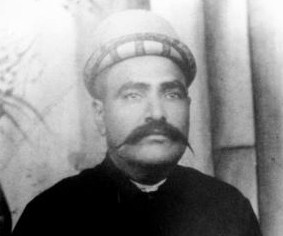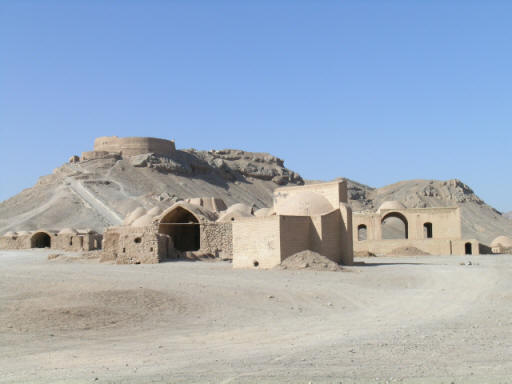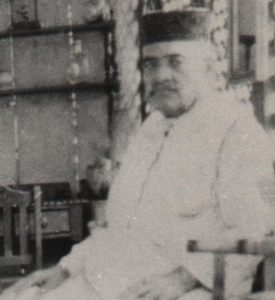Sheriar Mundegar Irani, circa 1893
Sheriar (Shahriyar) Mundegar Irani (1853-1932) was the Zoroastrian father of Meher Baba (1894-1969). His life affords an interesting variant of the substantial Irani emigration from Central Iran to India. This exodus, occurring over generations, was the consequence of oppression afflicting a religious minority.
Irani Zoroastrians were the original Persians, the real Iranians, an ethnic breed quite distinct from the Arabs and Turkic peoples who infiltrated Iran during the Islamic era. Over the centuries, their zone of habitation contracted to the regions of Yazd and Kerman, primarily the former. At Yazd, they lived mainly in villages on the Yazd plain (Boyce 1977). These rural Zoroastrian ghettos existed in the shadow of Shia Islam. Zoroastrians were officially tolerated, but nevertheless subject to harassments and insidious religious discrimination (Amighi 1990).
Zoroastrian dakhma (burial tower), Yazd
Sheriar Mundegar was born at the Yazdi village of Khorramshah. He was the son of Mundegar the salar, meaning the custodian of a local Zoroastrian dakhma (place of burial). At these sites, corpses were disposed of in the traditional manner, being left for vultures to devour. The salar guarded the corpses, while performing basic rites for the dead. Mundegar was very unusual in being the follower of an obscure Muslim saint at Khorramshah (Kalchuri 1986:120). Because of this allegiance, local Muslims were more tolerant of his family than would otherwise have been the case.
Irani Zoroastrians lived in constant fear of abuse. They were known contemptuously as guebres or “fire worshippers.” Restrictions applied to the size of their houses, also their mode of travel. They could not openly trade; their lifestyle was frequently that of agricultural workers. The presiding legists were mullas, a religious party indifferent to infidel complaints. “If a Zoroastrian was murdered, no one was punished” (Anzar 1976:4).
Mistreatment from the local Muslim population and clergy was more severe at Yazd than in the Kerman milieu (Sanasarian 2000:49). Many travellers to Iran commented on the Zoroastrian plight. E. G. Browne referred to the “savage brutality of lutis,” a category described as hooligans (Browne 1893:371; Shepherd 1988a:13-14). While Browne was in Yazd, a Zoroastrian was bastinadoed for accidentally touching with his garment some fruit for sale in the bazaar, rendering this commodity unclean for true believers (Browne 1893:371-2).
The Irani Zoroastrians dreaded attacks on their women. A Zoroastrian girl was raped while carrying farm produce to the city. The Muslim attackers callously claimed that she was drunk, and therefore responsible for the crime. The victim could not endure the stigma imposed upon her, and committed suicide by burning herself (Jahanian 1996). Other girls are reported to have been forcibly converted to Islam.
Young Sheriar himself foiled a molestation when a group of Muslims on horseback were chasing a young and attractive Zoroastrian woman. He concealed this fugitive at the site of the dakhma he tended with his father (Anzar 1974:2). The pursuers had broken into a Zoroastrian house. Other reports confirm that Muslims would kidnap Zoroastrian girls and convert them to Islam via marriage. Converts would be paraded in the Yazd bazaar as a sign of Islamic triumph (Amighi 2014). Another version is that abductors would have the girls “married to Muslims in other areas or sell them as concubines” (Kalchuri 1986:121 endnote). A frequent destination of the victims was Arabia. “In this way the Muslim fanatics reduced the Zoroastrian population” (ibid). In his description of 1850s abuses, the Parsi traveller Maneckji Hataria wrote: “Vagrants have kidnapped their [Irani] women and daughters” (Jahanian 1996). Some abductors seem comparable to slave traders. However, Qajar Iran is much better known for other aspects of the widespread slave trade (Mirzai 2017).
The feared lutis were involved in murders. Circa 1870, two Zoroastrians were attacked outside Yazd by two Muslims. One victim was killed, the other very badly wounded, as the aggressors tried to cut off his head (Malcolm 1908:50). Violence was too often preferred. Oppressive collectors of the jizya tax would tie a man to a dog (a despised Zoroastrian pet) and beat both of the victims until the stipulated money was given, amounting to a labourer’s wage for ten days (ibid:47). Not to be outdone in such excesses, the pious Shia mujtahids (elite clerics) made Zoroastrians stand on one leg inside their (Muslim) houses “until they consented to pay a considerable sum of money” (ibid:48).
The French ambassador to Qajar Iran wrote pessimistically: “A miracle may save them [Irani Zoroastrians] from extinction” (Jahanian 1996). In the mid-nineteenth century, the village of Turkabad, near Yazd, suffered a forced mass conversion of Zoroastrians (Boyce 1977:7; Boyce 1992:158). This event is sometimes described in terms of a massacre. There were apparently less than 7,000 Zoroastrians surviving at Yazd during the 1850s. The Parsi mission of Maneckji Hataria attempted to improve the situation, although meeting opposition from conservative Irani priests (Ringer 2011:152ff).
The young salar Sheriar Irani departed from Yazd in 1865-66. He was not merely fleeing from harassment. He became a mendicant committed to Yazdan (the Zoroastrian God). He is often referred to as a dervish, a word generally denoting a Muslim mendicant. However, he remained a Zoroastrian. His father’s intimacy with a Muslim saint may have imparted to Sheriar a degree of affinity with mystical Islam. Sheriar grew accustomed to the wilderness, which he regarded as a haven from interference. This was a very tough life, sandstorms being only one of the problems. A strong walker, he learned how to survive, adapting as best he could to the surrounding Muslim society.
After eight years of wandering, he emigrated to India with his brother Khododad. They arrived in Bombay circa 1874, taking employment. Their environment was now that of Parsis, the Zoroastrian community of Western India commencing many centuries earlier (Palsetia 2001). After the British took possession of Bombay in 1662, Parsis converged there in large numbers, flourishing as traders or sethias (Hinnells and Williams 2008:1). See also Bombay communities. A major influence in this city, during the early nineteenth century, was Sir Jamshetji Jejeebhoy (1783-1859), the Parsi merchant and philanthropist, and the first Indian to be knighted (Palsetia 2015).
Unlike Khododad, Sheriar did not pursue wealth. Instead, he again departed as a mendicant, effectively vanishing during the years 1874-1883. After a severe thirty day fast and vigil (chilla), he returned to the urban sector (in 1883 or 1884), his body emaciated. He had experienced a powerful dream, which conveyed that he could not himself attain God – instead his future son would do so. This intimation caused mental turmoil; his mind was divided between the prospect of a family and his dedication to the renunciate life.
Although seriously weakened from fasting, Sheriar now walked over four hundred miles south from Gujarat. He arrived in Poona (Pune), finding the home of his sister Piroja, who had likewise emigrated from Yazd. She had given up hope of ever seeing Sheriar again. Piroja could not understand his ascetic way of life. She wanted him to marry and settle down. Sheriar reacted, repeatedly telling her that he intended to resume mendicancy. Piroja was upset and wept.
Eventually Sheriar adopted a different tactic. Gazing out of the window, he pointed to the five (or six) year old daughter of an Irani neighbour, saying that if he had to marry, then he would marry this little girl. Sheriar did not believe that his suggestion would be taken seriously. He was astounded when his persistent sister arranged the match (Kalchuri 1986:130-137; Shepherd 1988a:52-57). The marriage was scheduled years in the future.
Sheriar felt obliged to honour his word. The Zoroastrian ethical code stressed truthfulness. A promise was considered irrevocable. This feature of integrity converged with the Zoroastrian religious tenet of “good words” (hukhta), associated with the ancient prophet Zarathushtra (Boyce 1992:90).
He commenced to earn a livelihood, at first working in Poona as a gardener at a Parsi mansion, where plants flourished in his care. Eventually he married Shirin Irani, as he had promised, in 1892. He was then 39, while she was 14 years old. Sheriar became a businessman, in the interests of supporting his growing family of several children. His simple terraced house was near the Poona cantonment, in a locality then known as Butler Moholla. In 1919, he acquired a larger house in the same lane, opposite the earlier home (Irani 1965:23). The ambience was middle class. However, neither of these properties were comparable to the fine mansions of wealthy Parsi celebrities. Sheriar maintained a business because he had to, not because he wanted to. He was eventually the proprietor of a string of toddy shops, employing assistants. At that period, many Parsis in Gujarat made their living from the production of toddy, a mild alcoholic drink.
Meanwhile, during the 1880s, he taught himself to read and write. Not only did he learn Persian, but also Arabic. He spoke with his family in Dari, meaning the Irani language used at Yazd (more specifically, Zoroastrian Dari in the Yazdi dialect was divided into many variants relating to neighbourhood). His daughter says that Sheriar had an imperfect knowledge of Gujarati, which he spoke with an Irani accent (Irani 1993:52). Gujarati was the vernacular language of Parsis, associated with the neighbouring state of Gujarat (Shirin could speak fluent Gujarati, being reared in this language). In contrast, Arabic was a very unusual linguistic interest amongst Zoroastrians. Sheriar became acquainted with both Sufi and Zoroastrian texts. He taught Shirin Persian, reading to her the Shah-Nama and Divan of Hafiz. Sheriar also wrote mystical poetry in Persian.
His daughter Mani later related that he was consulted by a scholar engaged in the translation of a text from Arabic to Persian. She actually saw him “help a well known [Parsi] professor to correct some manuscript in Arabic” (Irani 1993:60). Mani also relayed that her father would talk in Hebrew with a woman who lived in the same lane at Poona. Exactly how Sheriar came to learn Hebrew is not known. “I would hear Father converse in Hebrew with a charming old Jewish lady who wore dozens of bangles” (ibid). A Jewish community had existed at Yazd; however, any early connection of Sheriar with that colony seems unlikely.
Mani wondered how her father could speak these languages so well (in contrast to his more pedestrian Gujarati). She questioned him on this matter. Sheriar was reticent; he merely remarked that the acquisition “came to me suddenly, in a moment” (ibid). Years later, Mani asked her brother Meher Baba how such knowledge could be possible. The cryptic reply is reported as: “Knowledge is all inside, hidden behind a curtain” (ibid). We know that Sheriar was self-taught at Poona; his approach to learning was apparently not typical of either autodidacts or academics.
The Dabistan informs that two Jewish rabbis became followers of the Kaivan circle in the early seventeenth century. Hebrew was not necessary for the study of Kaivani texts. However, the inter-religious disposition of that circle must have impressed Sheriar. Relevant works like the Dabistan and Desatir were well known in literary circles of his time. Like the Kaivanis, Sheriar believed in reincarnation. Many Parsis became Theosophists, unlike Sheriar, who moved in another direction. He may be described as a neo-Kaivani, an independent identity not related to any sect or movement.
Sheriar learned to some degree the local Marathi, but did not assimilate English. However, he had nothing against the British. Zoroastrians benefited from the tolerant colonial regime. For generations until circa 1860, the mercantile activity of Iranis at Yazd had been much restricted, literally occurring underground, operating in cellars of their houses as a consequence of Islamic prohibition (Malcolm 1905:46-47). Now, in India, they were free to prosper alongside the Parsis.
Enterprising Parsis built and ran the Bombay dockyard, were the leading ship owners of India, were pioneers in education and social reform, were leaders in banking, law, and the Indian industrial revolution (Hinnells and Williams 2008a:2). At Poona, some Parsis established factories. The earliest Parsi settlers here were traders, but many became professional people, e.g., lawyers, doctors, academics. Parsi philanthropists made generous donations to educational institutions such as the Deccan College.
Some of the most imposing houses in Poona were owned by Parsis, whose social functions attracted many British officials. Circa 1900, there were 1,900 Parsis in Poona, many of them affluent. In contrast, numerous Iranis arrived as refugees; most of these newcomers were not wealthy (Hinnells 2008b). Iranis were far more at the working class level. Accordingly, Parsis tended to regard themselves as superior. There is a general lack of information about the Iranis in Poona, Sheriar being an exception.
Sheriar Irani at Poona in the 1920s
The education of Parsis generally followed a Westernised model. Sheriar was not a participant in this trend, remaining a mystic who did not study for a career. Some wealthy Parsi families gained many servants. Sheriar’s family had only one servant, a Hindu lady named Chandri, whom they employed in the 1920s. Sheriar was not a gourmet. He maintained a habit of selecting the most imperfect food for himself, for instance, a blemished apple. His daughter Mani says that he would quickly put such items on his plate, not saying a word. “As a child, she [Mani] noticed such selfless acts” (Fenster 2013:230).
The ex-mendicant Irani was not typical of the business sector. His wife Shirin was often exasperated by his lack of interest in mundane acquisitions and savings. Mani related that her mother did not trust Sheriar with money, the reason being that he would so frequently give away cash to beggars and ascetics. The benign Sheriar had exactly the same tendency with blankets. Shirin complained that she could have opened a blanket shop if they had kept all the blankets her husband had so generously gifted (audio source). In this action, Sheriar was similar to Hazrat Babajan (d.1931), the Muslim faqir whose latitude to the poor became famous. Sheriar was an acquaintance of Babajan, who lived nearby in the same area of Poona (Shepherd 2014:49-50).
Sheriar Irani was constantly muttering “Yazdan, Yazdan,” a Zoroastrian sacred name. This was not an ostentatious exercise, instead scarcely audible, and often completely silent. His daughter informs: “I would look up to catch a glimpse of the tip of his tongue moving up and down as he silently repeated God’s name” (Irani 1993:57).
Silence was a frequent characteristic. Mani relays that a local businessman was deeply impressed with Sheriar, and would visit his home. The two would sit in silence for hours at a time. Shirin would become annoyed, asking the visitor when he was going to leave; she would tell him to come to the point. The visitor is reported to have replied; “I do not come here to talk to Sheriar, I just like to sit in his presence. I feel so peaceful sitting here with him” (audio source).
In another report, Mani writes: “Many a family friend or acquaintance has come into our home to sit for hours beside him [Sheriar] in total silence” (Irani 1993:57). The reason supplied is that the visitors gained peace of mind.
When Mehera J. Irani (along with other visitors) encountered Sheriar in December 1924 (or January 1925), she found that he “would sit away from the others, quietly repeating Yezdan, the Zoroastrian name of God” (Fenster 2013:158). He was still partial to horticulture; Mehera noticed the violets growing in his garden at Butler Moholla.
During the early 1920s, the elderly Sheriar lost his business to a dishonest employee. He was indifferent to the loss of income (Shepherd 1988a:73-75). He maintained his composure, acting as though the outer world was of no consequence by comparison with the inner world.
Some orthodox Parsis of Poona were critics of his son Meher Baba, whom they considered a heretic. This hostile group bribed a policeman who had alcoholic tendencies. The agitators made the policeman drunk, exhorting him to visit Sheriar and administer a beating. The inebriated officer of the law complied with the request, threateningly entering Sheriar’s house. The old man simply gazed at the intruder, who shouted abuse. Sheriar did not react. The interloper failed in his mission; no violence occurred. However, neighbours were outraged by this unseemly event; they made the policeman apologise afterwards to his intended victim (audio source). These neighbours were not Zoroastrians. Their identity is uncertain. Butler Moholla was inhabited by “Christians, Zoroastrians, Jews, Muslims, Hindus, Buddhists” (Irani 1993:19).
Another visitor to the home of Sheriar had a deeper comprehension than most others. Sadhu Christian Leik (d. 1929) was an unusual ascetic from Esthonia who became a disciple of Meher Baba in 1928. Mani reported that Leik would sit in silence with Sheriar for hours. Both of these men were contemplatives who did not feel a need for words.
Bibliographic Note:
The early published account in Purdom 1937:14-16 has some errors, including the mistaken date of 1879 for the marriage of Sheriar and Shirin. Purdom also says that Sheriar “returned to Bombay and went to his sister Piroja’s house – there he stayed.” The traveller did return to Bombay, but quickly moved on to his sister’s home in Poona, a place name omitted by Purdom. This misleading version influenced a Wikipedia article on Sheriar (subsequently deleted), which stated that Piroja lived in Bombay, and that Sheriar and his wife moved to Poona in 1893. This error was mistakenly attributed by the editor to Maud Kennedy. In fact, the Kennedy article correctly identifies Poona as the location, following Jal S. Irani (without supplying any source). Only weeks after Shirin Irani was born at Bombay, her parents moved to Poona in the late 1870s, where her father Dorab Irani opened a tea shop. The date Purdom mistook for the marriage was actually the time when Dorab and his family moved to Poona. The contraction about Bombay is repeated in Purdom 1964:16; however, the date of marriage is duly revised to 1892. The date of Sheriar’s birth here is still unsatisfactory, being five years too late. The article by Sheriar’s son Jal Irani was a basic source for Maud Kennedy, a British devotee of Meher Baba. Both of these articles lack details afforded in subsequent published materials and oral transmission. Jal says that Sheriar left home “when he was barely thirteen years of age” (Irani 1965:16). There are slight differences in the reports. Cf. Kalchuri 1986:122, stating “he was only twelve years old.” Other writers give the age as thirteen. Jal gives no date for the voyage from Iran to Bombay; he says that his father eventually owned “several toddy and tea shops” (Irani 1965:22). Jal informs that Sheriar gained “a scholarly knowledge of the Persian and Arabic languages” (ibid:21), but does not mention the acquisition of Hebrew. The 1976 article by Naosherwan Anzar supplied very relevant material resulting from fieldwork on the Yazd plain. Bhau Kalchuri, and the editorial process of Lord Meher, supplied two chapters on Sheriar and Shirin. Major informants about Sheriar Irani were his children Mani S. Irani and Adi S. Irani. Mani’s version is represented in Lord Meher. She is described as having “authenticated” the relevant chapters. Adi is not represented. He never wrote anything, but did make references in conversation. Adi was acknowledged in Shepherd 1988a:82. “I am indebted to Sheriar’s son Adi S. Irani for certain background data.” My book supplied the longest version of Sheriar’s biography, together with details about the Kaivan circle and their literature. A second edition is planned. Some readers mistakenly assumed that my diachronic association was intended as a sectarian identity; careful reading will dispel this error. Adi was in awe of his father, whom he considered an excelling example of the “be in the world but not of it” ideal. Adi emphasised the unusual extent of Sheriar’s philanthropy, and believed that only Merwan (Meher Baba) was fully conversant with the range of their father’s studies. My earliest version of Sheriar was in the unpublished manuscript Life of Meher Baba, the chapter on Sheriar dating to 1967. See also the index references to Sheriar Irani in Shepherd 1988b:302; Shepherd 2005:310. The details contributed by Mani S. Irani (1918-1996) were partly in oral and audio transmission, the audio materials emerging online. Her written version is Irani 1993:52-61. On Mehera J. Irani (1907-1989), see Fenster 2013. Concerning the phenomenon of Parsi success, “they [Parsis] are now India’s smallest community, yet they are among those who have exercised the greatest influence on the Subcontinent, having been foremost in so many areas all out of proportion to their demographic size” (Hinnells and Williams 2008a:1).
Bibliography:
Amighi, Janet Kestenberg, The Zoroastrians of Iran: Conversion, Assimilation, or Persistence (New York: AMS Press, 1990).
Anzar, Naosherwan, The Beloved: The Life and Work of Meher Baba (North Myrtle Beach, SC: Sheriar Press, 1974).
———“In Search of God’s Ancestry,” The Glow Quarterly (August 1976) 11(3):3-10.
Boyce, Mary, A Persian Stronghold of Zoroastrianism (Oxford: Clarendon Press, 1977).
——–Zoroastrianism: Its Antiquity and Constant Vigour (Costa Mesa, California: Mazda Publishers, 1992).
Browne, Edward G., A Year Amongst the Persians (London: Adam and Charles Black, 1893).
Fenster, David, Mehera-Meher Vol. 1 (second edn, Ahmednagar: Meher Nazar, 2013).
Hinnells, John R., The Zoroastrian Diaspora: Religion and Migration (New York: Oxford University Press, 2005).
Hinnells, John R., and Alan Williams, eds., Parsis in India and the Diaspora (London and New York: Routledge, 2008).
Irani, Jal S., “Biographical Notes on Avatar Meher Baba’s Parents,” Divya Vani (Jan. 1965) 2(1):15-23.
Irani, Mani S., God-Brother: Stories from my Childhood with Meher Baba (Myrtle Beach, SC: Sheriar Foundation, 1993).
Kalchuri, Bhau, Feram Workingboxwala, David Fenster et al, Lord Meher Vol. 1 (North Myrtle Beach, SC: Manifestation, 1986).
Kennedy, Maud, “Sheriarji: The Wandering Dervish,” Glow International (August 1985):11-13.
Malcolm, Napier, Five Years in a Persian Town (London: John Murray, 1908).
Mirzai, Behnaz A., A History of Slavery and Emancipation in Iran 1800-1929 (Austin: University of Texas Press, 2017).
Palsetia, Jesse S., The Parsis of India: Preservation of Identity in Bombay City (Leiden: Brill, 2001).
——–Jamsetjee Jejeebhoy of Bombay: Partnership and Public Culture in Empire (New Delhi: Oxford University Press, 2015).
Purdom, Charles, The Perfect Master: The Life of Shri Meher Baba (London: Williams and Norgate, 1937).
———The God-Man (London: George Allen and Unwin, 1964).
Ringer, Monica M., Pious Citizens: Reforming Zoroastrianism in India and Iran (Syracuse, New York: Syracuse University Press, 2011).
Sanasarian, Eliz, Religious Minorities in Iran (Cambridge and New York: Cambridge University Press, 2000).
Shepherd, Kevin R. D., From Oppression to Freedom: A Study of the Kaivani Gnostics (Cambridge: Anthropographia, 1988a).
———Meher Baba, an Iranian Liberal (Cambridge: Anthropographia, 1988b).
———Investigating the Sai Baba Movement (Dorchester: Citizen Initiative, 2005).
———Hazrat Babajan: A Pathan Sufi of Poona (New Delhi: Sterling, 2014).
Kevin R. D. Shepherd
November 2017 (modified 2021)
ENTRY no. 73
Copyright © 2021 Kevin R. D. Shepherd. All Rights Reserved.




